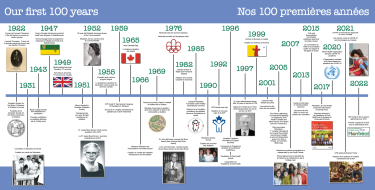A snapshot of our first hundred (or so) years
In 1922, 15 physicians from Ontario and Quebec founded the Canadian Society for the Study of Diseases of Children. They were responding in part to increasing rates of infant mortality and childhood infectious diseases in Canada, but their charter recorded two goals that remain at the heart of CPS work today:
- To advance the knowledge of physiology, pathology, psychology and therapeutics of infancy and childhood, and
- To facilitate for its members the means of acquiring fuller knowledge by professional meetings, and by the publication of articles and papers relating to the science, practice and teaching of the diseases of infancy and childhood.
Today, the Canadian Paediatric Society (which got its new name in 1951) has almost 4000 members, whose care of children and youth now embraces advocacy, professional and public education, and surveillance.
The first annual meeting was held in Montreal in 1923 and, in addition to founding members, drew 9 attendees, including 2 women. The first paper presented was “Acute intestinal intoxication in infants”, by Drs. Alan Brown and Gladys Boyd. CPS meetings have been held every year since: across Canada and often combined with allied organizations like the American Academy of Pediatrics, state or regional paediatric societies, the British Paediatric Association, or the Society for Paediatric Research. The CPS hosted three large international conferences, in 1959, 1967, and 2016.
Almost since inception, the CPS has done much of its work through committees focused on specific areas of child and youth health. An education committee was struck in 1931, charged with studying teaching programs for undergraduate medical students in Canada. Other committees followed over the years, including Nutrition (1959), First Nations and Inuit Child Health (1962), and Infectious Diseases and Immunization (1966). Today, the CPS has 30 authoring committees, sections and task forces producing position statements and practice points for physician guidance, advocacy, and public dissemination.
One of the first questions debated by founders in 1922 was whether their new organization should be “Dominion-wide”. Doctors in Western Canada had stronger ties stateside than with peers in Ontario or Quebec, and it was not until the mid-20th century that the CPS became a truly national entity. An especially successful conference in Banff in 1946 helped renew Western participation, and a new constitution in 1950 explicitly recognized CPS roots in Quebec. The essential character of the CPS was fully realized under the leadership of Dr. Victor Marchessault, who established the first “secretariat” in Sherbrooke in 1964 to serve a fast-growing membership and went on to lead the organization for over 30 years. Today, the CPS has members from coast to coast to coast, and creation of the Residents Section in 1990—the largest of all CPS working groups—ensured that paediatricians-in-training from programs across Canada have a first professional ‘home’ for their skills and learning.
Despite its increasingly national scope, CPS membership was small, and predominantly male and “undiverse” for a long time. There were always shining exceptions, however. Dr. Alton Goldbloom was a founding member and later president of the CSSDC in an era when Jews were actively discriminated against in Canada’s medical schools and hospitals. His son, Dr. Richard Goldbloom, was also a pre-eminent CPS member and president, and his granddaughter, Dr. Ellen Goldbloom, is a member today. Dr. Jessie Boyd Scriver was one the first women to study medicine at McGill University, and she was the first to serve as CPS president in 1952. The first Indigenous paediatrician in Canada, Dr. Kent Saylor, led CPS work on First Nations, Inuit and Métis child and youth health for many years, and broke ground for a growing number of Indigenous members. Today, the CPS is working hard to become an actively antiracist organization to ensure a more equitable, diverse, and inclusive future.
Advocacy is an ever-stronger focus of CPS work, thanks to executive leadership and dedicated members. Historic successes where our involvement has played a key role include immunization and specific vaccines, vitamin D-fortified milk, water fluoridation, infant and child car safety seats, ‘back-to-sleep’ for babies, a ban on baby walkers, in-school response to children with type 1 diabetes, and gun control legislation, to name but a few. Today, new leading strategic priorities—mental health, environmental health, and the paediatric workforce—promise to inspire and inform the work we do for years to come.
Last updated: Oct 1, 2024

